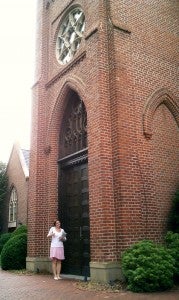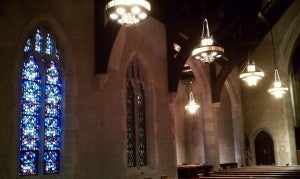By: Maura Farver, 2011 Climate Corps Public Sector Fellow at First Presbyterian Church in Asheville, NC; MEM candidate at the Nicholas School of the Environment, Duke University; MBA Candidate at UNC Kenan-Flagler
 My summer fellowship with Climate Corps Public Sector brought me to First Presbyterian Church. In my search for energy efficiency, I have come to call the church my 1000 piece summer jigsaw puzzle. Every piece is a little different and must be closely examined. Fortunately, I love puzzles and am always up for a challenge.
My summer fellowship with Climate Corps Public Sector brought me to First Presbyterian Church. In my search for energy efficiency, I have come to call the church my 1000 piece summer jigsaw puzzle. Every piece is a little different and must be closely examined. Fortunately, I love puzzles and am always up for a challenge.
The church’s main sanctuary was built in 1884, and over the years, there have been various building additions and technology upgrades. Developing an accurate tally of the lighting, HVAC, electronics, and building materials at the church was trickier than I anticipated.
The church is unique, and in understanding how energy is consumed here, I need to know:
- What lighting and electronic equipment are in use in each room?
- How is temperature regulated throughout the building?
- What parts of the building are in use and how often?
Robert Bauman, the church’s very patient and knowledgeable maintenance guru, and I have diligently catalogued the energy use on all 64,000 square feet of the church. I’m proud to report that we are finally done! It’s like completing the perimeter of the puzzle!
Some surprises I’ve discovered are:
- The newest building addition uses T8 bulbs, while the older sections use inefficient T12 bulbs. There are over 500 T12 bulbs on the property.
- Two boilers serve the property, but cooling is more complicated. There is a mix of window air conditioning units, a chiller system, and split air conditioning units.
- The sanctuary and chapel are mainly used on Sunday mornings, but the offices and childcare floor are used every weekday. The conference rooms and classrooms are used intermittently by community members.
The church has already implemented several energy efficiency upgrades, including adding insulation to the education building roof, switching from incandescent bulbs to CFLs, and installing an efficient chiller system. Compared to five years ago, they use 14% less energy!

However, there remain opportunities to reduce energy use, especially in lighting. The church has set aside funding for environmental projects, so the next step in this puzzle is to change the exit sign lighting to LEDs. With a price tag of $19 plus a $25 rebate, the LED lights cost -$6 each.
Next, it’s on to building materials and insulation! Piece by piece, the image is becoming clear.
EDF Climate Corps Public Sector (CCPS) trains graduate students to identify energy efficiency savings in colleges, universities, local governments and houses of worship. The program focuses partnerships with minority serving institutions and diverse communities. Apply as a CCPS fellow, read our blog posts and follow us on Twitter to get regular updates about this program.










One Comment
I like your analogy: energy efficiency is like a puzzle. Not only are there a lot of pieces that come together to give you the whole picture, you always are challenged and learn something new.
It sounds like you’ve hit some of the low hanging fruit. These are often the recommendations with the fastest payback. With their boilers, complex HVAC, and lighting you probably can still find a lot of savings, even if they have changed to CFLs and T8 bulbs.